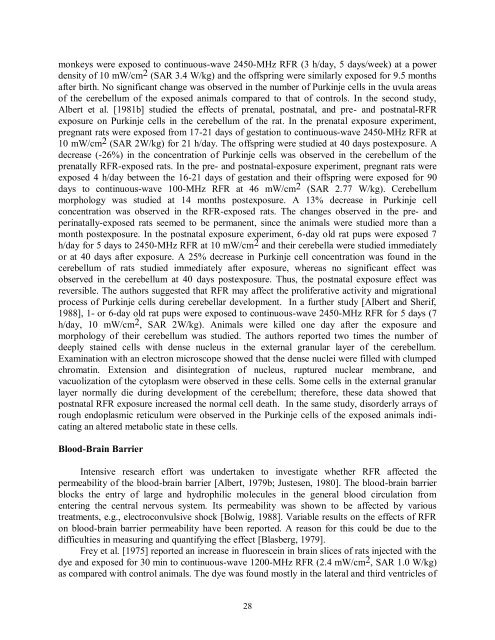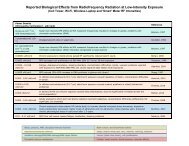Evidence for Effects on Neurology and Behavior - BioInitiative Report
Evidence for Effects on Neurology and Behavior - BioInitiative Report
Evidence for Effects on Neurology and Behavior - BioInitiative Report
Create successful ePaper yourself
Turn your PDF publications into a flip-book with our unique Google optimized e-Paper software.
m<strong>on</strong>keys were exposed to c<strong>on</strong>tinuous-wave 2450-MHz RFR (3 h/day, 5 days/week) at a power<br />
density of 10 mW/cm 2 (SAR 3.4 W/kg) <strong>and</strong> the offspring were similarly exposed <str<strong>on</strong>g>for</str<strong>on</strong>g> 9.5 m<strong>on</strong>ths<br />
after birth. No significant change was observed in the number of Purkinje cells in the uvula areas<br />
of the cerebellum of the exposed animals compared to that of c<strong>on</strong>trols. In the sec<strong>on</strong>d study,<br />
Albert et al. [1981b] studied the effects of prenatal, postnatal, <strong>and</strong> pre- <strong>and</strong> postnatal-RFR<br />
exposure <strong>on</strong> Purkinje cells in the cerebellum of the rat. In the prenatal exposure experiment,<br />
pregnant rats were exposed from 17-21 days of gestati<strong>on</strong> to c<strong>on</strong>tinuous-wave 2450-MHz RFR at<br />
10 mW/cm 2 (SAR 2W/kg) <str<strong>on</strong>g>for</str<strong>on</strong>g> 21 h/day. The offspring were studied at 40 days postexposure. A<br />
decrease (-26%) in the c<strong>on</strong>centrati<strong>on</strong> of Purkinje cells was observed in the cerebellum of the<br />
prenatally RFR-exposed rats. In the pre- <strong>and</strong> postnatal-exposure experiment, pregnant rats were<br />
exposed 4 h/day between the 16-21 days of gestati<strong>on</strong> <strong>and</strong> their offspring were exposed <str<strong>on</strong>g>for</str<strong>on</strong>g> 90<br />
days to c<strong>on</strong>tinuous-wave 100-MHz RFR at 46 mW/cm 2 (SAR 2.77 W/kg). Cerebellum<br />
morphology was studied at 14 m<strong>on</strong>ths postexposure. A 13% decrease in Purkinje cell<br />
c<strong>on</strong>centrati<strong>on</strong> was observed in the RFR-exposed rats. The changes observed in the pre- <strong>and</strong><br />
perinatally-exposed rats seemed to be permanent, since the animals were studied more than a<br />
m<strong>on</strong>th postexposure. In the postnatal exposure experiment, 6-day old rat pups were exposed 7<br />
h/day <str<strong>on</strong>g>for</str<strong>on</strong>g> 5 days to 2450-MHz RFR at 10 mW/cm 2 <strong>and</strong> their cerebella were studied immediately<br />
or at 40 days after exposure. A 25% decrease in Purkinje cell c<strong>on</strong>centrati<strong>on</strong> was found in the<br />
cerebellum of rats studied immediately after exposure, whereas no significant effect was<br />
observed in the cerebellum at 40 days postexposure. Thus, the postnatal exposure effect was<br />
reversible. The authors suggested that RFR may affect the proliferative activity <strong>and</strong> migrati<strong>on</strong>al<br />
process of Purkinje cells during cerebellar development. In a further study [Albert <strong>and</strong> Sherif,<br />
1988], 1- or 6-day old rat pups were exposed to c<strong>on</strong>tinuous-wave 2450-MHz RFR <str<strong>on</strong>g>for</str<strong>on</strong>g> 5 days (7<br />
h/day, 10 mW/cm 2 , SAR 2W/kg). Animals were killed <strong>on</strong>e day after the exposure <strong>and</strong><br />
morphology of their cerebellum was studied. The authors reported two times the number of<br />
deeply stained cells with dense nucleus in the external granular layer of the cerebellum.<br />
Examinati<strong>on</strong> with an electr<strong>on</strong> microscope showed that the dense nuclei were filled with clumped<br />
chromatin. Extensi<strong>on</strong> <strong>and</strong> disintegrati<strong>on</strong> of nucleus, ruptured nuclear membrane, <strong>and</strong><br />
vacuolizati<strong>on</strong> of the cytoplasm were observed in these cells. Some cells in the external granular<br />
layer normally die during development of the cerebellum; there<str<strong>on</strong>g>for</str<strong>on</strong>g>e, these data showed that<br />
postnatal RFR exposure increased the normal cell death. In the same study, disorderly arrays of<br />
rough endoplasmic reticulum were observed in the Purkinje cells of the exposed animals indicating<br />
an altered metabolic state in these cells.<br />
Blood-Brain Barrier<br />
Intensive research ef<str<strong>on</strong>g>for</str<strong>on</strong>g>t was undertaken to investigate whether RFR affected the<br />
permeability of the blood-brain barrier [Albert, 1979b; Justesen, 1980]. The blood-brain barrier<br />
blocks the entry of large <strong>and</strong> hydrophilic molecules in the general blood circulati<strong>on</strong> from<br />
entering the central nervous system. Its permeability was shown to be affected by various<br />
treatments, e.g., electroc<strong>on</strong>vulsive shock [Bolwig, 1988]. Variable results <strong>on</strong> the effects of RFR<br />
<strong>on</strong> blood-brain barrier permeability have been reported. A reas<strong>on</strong> <str<strong>on</strong>g>for</str<strong>on</strong>g> this could be due to the<br />
difficulties in measuring <strong>and</strong> quantifying the effect [Blasberg, 1979].<br />
Frey et al. [1975] reported an increase in fluorescein in brain slices of rats injected with the<br />
dye <strong>and</strong> exposed <str<strong>on</strong>g>for</str<strong>on</strong>g> 30 min to c<strong>on</strong>tinuous-wave 1200-MHz RFR (2.4 mW/cm 2 , SAR 1.0 W/kg)<br />
as compared with c<strong>on</strong>trol animals. The dye was found mostly in the lateral <strong>and</strong> third ventricles of<br />
28



